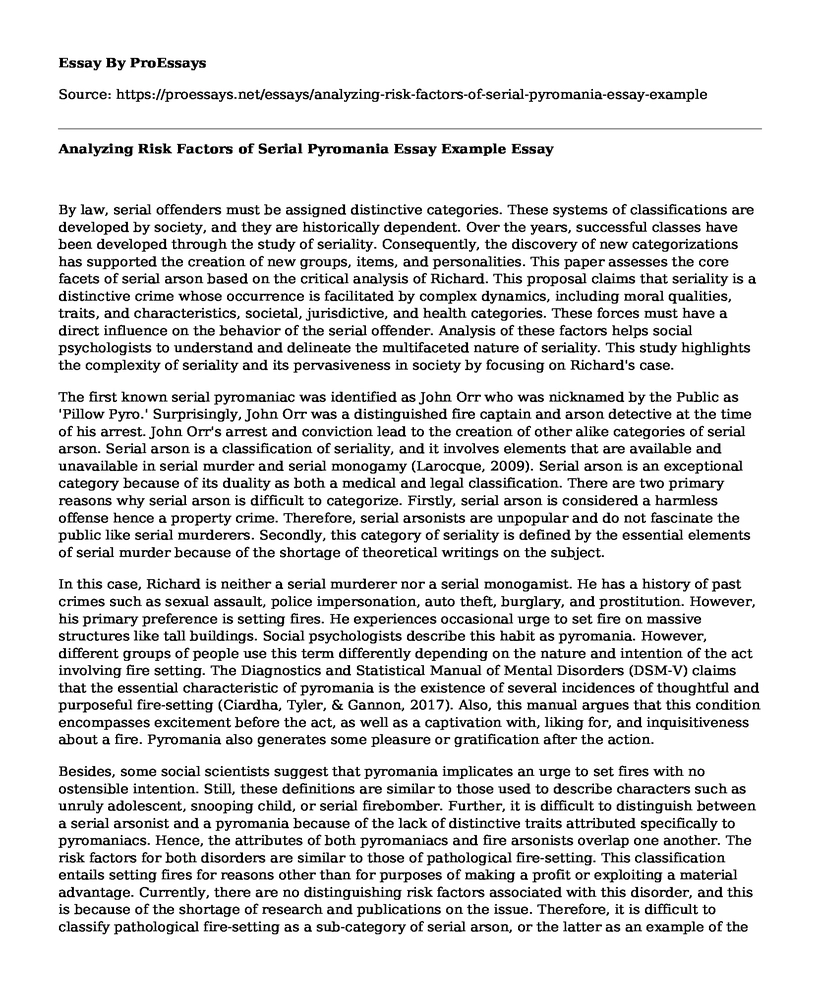By law, serial offenders must be assigned distinctive categories. These systems of classifications are developed by society, and they are historically dependent. Over the years, successful classes have been developed through the study of seriality. Consequently, the discovery of new categorizations has supported the creation of new groups, items, and personalities. This paper assesses the core facets of serial arson based on the critical analysis of Richard. This proposal claims that seriality is a distinctive crime whose occurrence is facilitated by complex dynamics, including moral qualities, traits, and characteristics, societal, jurisdictive, and health categories. These forces must have a direct influence on the behavior of the serial offender. Analysis of these factors helps social psychologists to understand and delineate the multifaceted nature of seriality. This study highlights the complexity of seriality and its pervasiveness in society by focusing on Richard's case.
The first known serial pyromaniac was identified as John Orr who was nicknamed by the Public as 'Pillow Pyro.' Surprisingly, John Orr was a distinguished fire captain and arson detective at the time of his arrest. John Orr's arrest and conviction lead to the creation of other alike categories of serial arson. Serial arson is a classification of seriality, and it involves elements that are available and unavailable in serial murder and serial monogamy (Larocque, 2009). Serial arson is an exceptional category because of its duality as both a medical and legal classification. There are two primary reasons why serial arson is difficult to categorize. Firstly, serial arson is considered a harmless offense hence a property crime. Therefore, serial arsonists are unpopular and do not fascinate the public like serial murderers. Secondly, this category of seriality is defined by the essential elements of serial murder because of the shortage of theoretical writings on the subject.
In this case, Richard is neither a serial murderer nor a serial monogamist. He has a history of past crimes such as sexual assault, police impersonation, auto theft, burglary, and prostitution. However, his primary preference is setting fires. He experiences occasional urge to set fire on massive structures like tall buildings. Social psychologists describe this habit as pyromania. However, different groups of people use this term differently depending on the nature and intention of the act involving fire setting. The Diagnostics and Statistical Manual of Mental Disorders (DSM-V) claims that the essential characteristic of pyromania is the existence of several incidences of thoughtful and purposeful fire-setting (Ciardha, Tyler, & Gannon, 2017). Also, this manual argues that this condition encompasses excitement before the act, as well as a captivation with, liking for, and inquisitiveness about a fire. Pyromania also generates some pleasure or gratification after the action.
Besides, some social scientists suggest that pyromania implicates an urge to set fires with no ostensible intention. Still, these definitions are similar to those used to describe characters such as unruly adolescent, snooping child, or serial firebomber. Further, it is difficult to distinguish between a serial arsonist and a pyromania because of the lack of distinctive traits attributed specifically to pyromaniacs. Hence, the attributes of both pyromaniacs and fire arsonists overlap one another. The risk factors for both disorders are similar to those of pathological fire-setting. This classification entails setting fires for reasons other than for purposes of making a profit or exploiting a material advantage. Currently, there are no distinguishing risk factors associated with this disorder, and this is because of the shortage of research and publications on the issue. Therefore, it is difficult to classify pathological fire-setting as a sub-category of serial arson, or the latter as an example of the former.
References
Ciardha, C. O., Tyler, N., & Gannon, T. A. (2017). Pyromania. In Handbook of DSM-5 Disorders in Children and Adolescents (pp. 529-538). Springer, Cham.
Larocque, R. M. (2009). Serials: The Contested and Contextual Meanings of Seriality (Doctoral dissertation, University of Alberta).
Cite this page
Analyzing Risk Factors of Serial Pyromania Essay Example. (2022, Dec 10). Retrieved from https://proessays.net/essays/analyzing-risk-factors-of-serial-pyromania-essay-example
If you are the original author of this essay and no longer wish to have it published on the ProEssays website, please click below to request its removal:
- Essay on Native People Living in the US
- Paper Example on Occupational Crime: Joel Morehu-Barlow "The Tahitian Prince"
- American History From 1877 to Current Essay
- Legalization of Marijuana Production for Individual Use Essay Example
- School-to-Prison Pipeline - Essay Sample
- Essay Example on Jury Trial: Advantages Over Bench Trial
- Essay Example on Murder of 7-Yr-Old: Examining Family Violence & Crime







